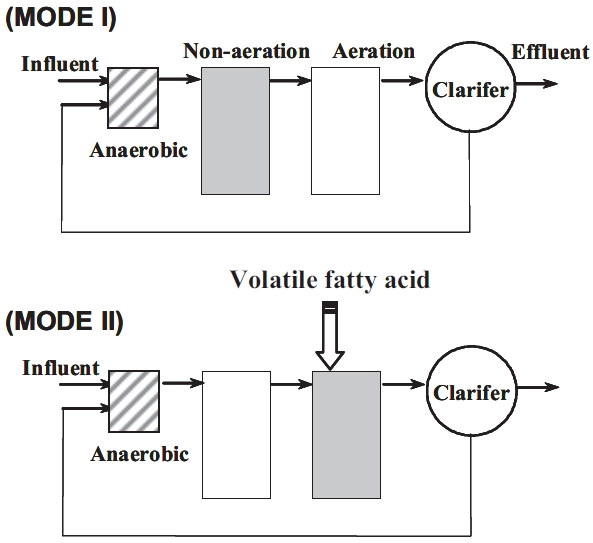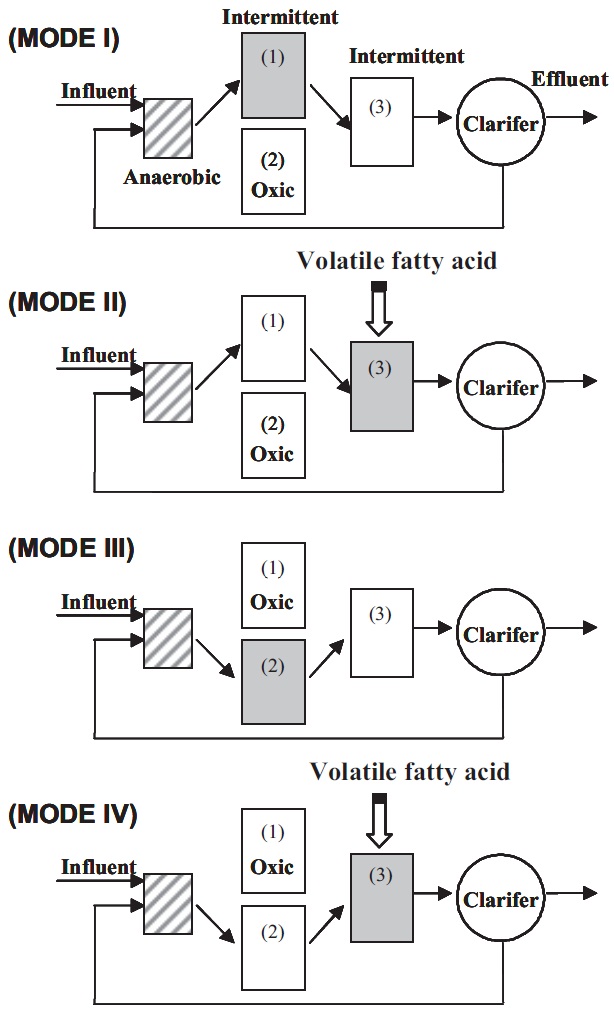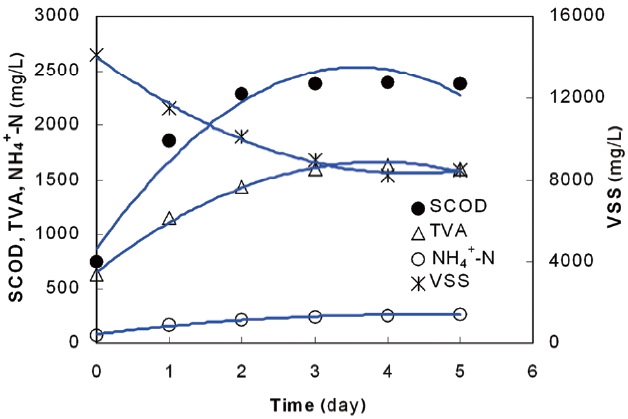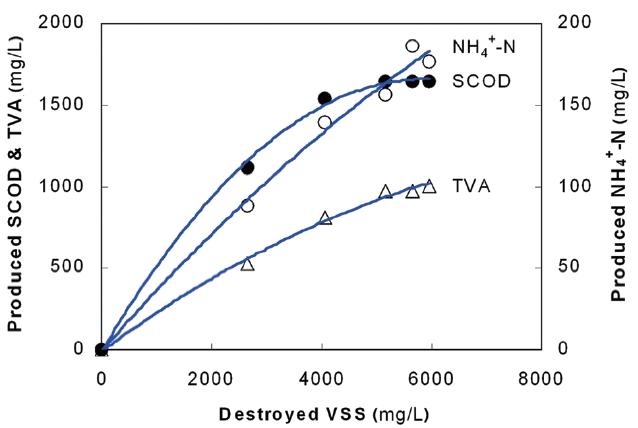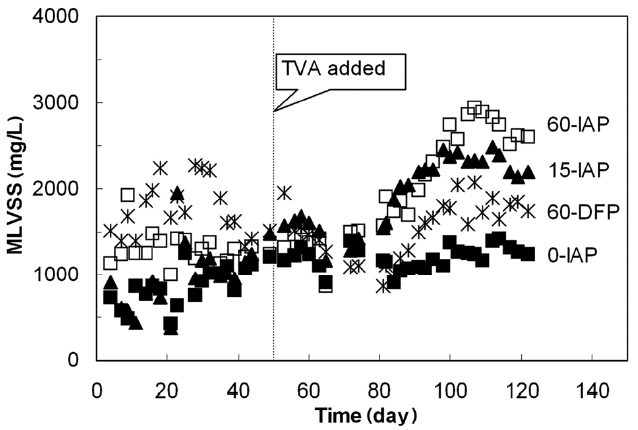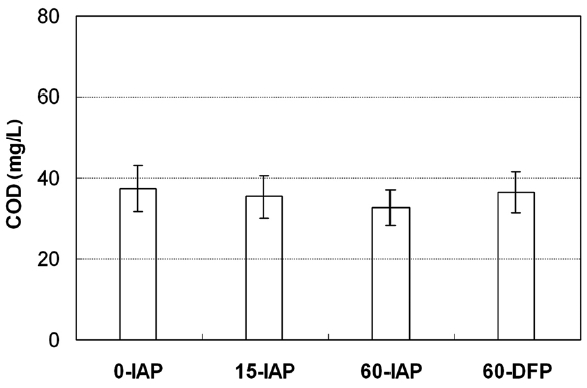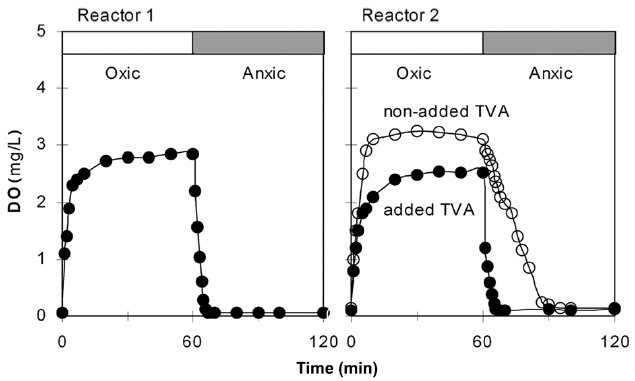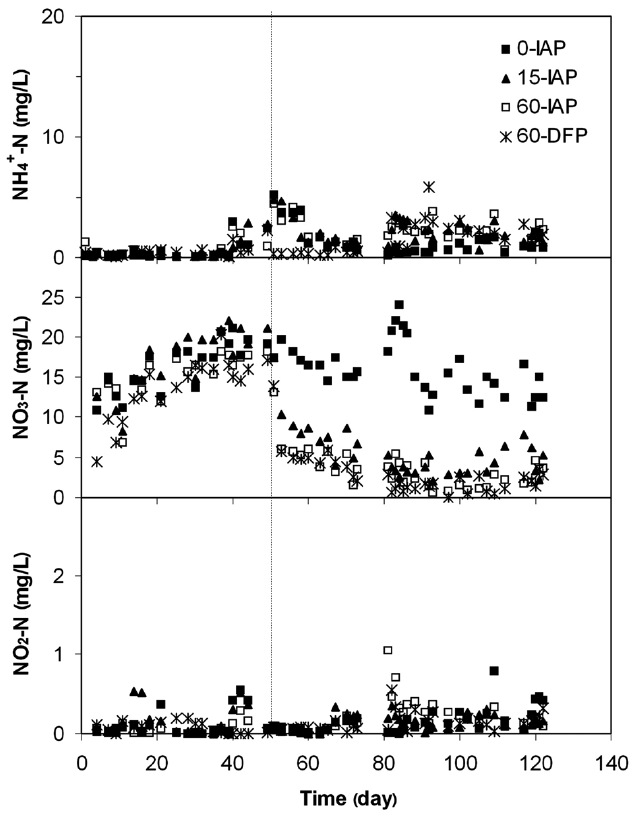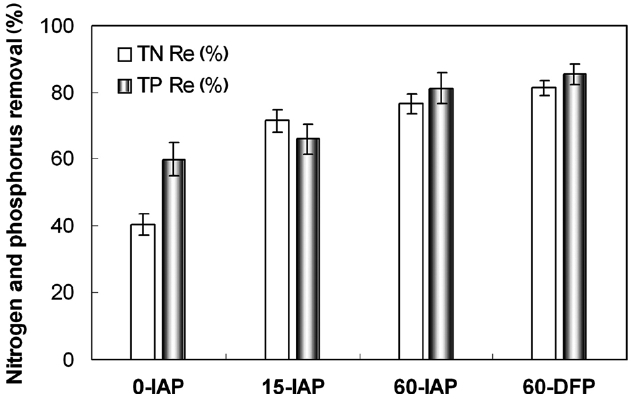



The two-stage intermittent aeration activated sludge process (IAP) and dynamic-flow intermittent aeration activated sludge process (DFP) were investigated for the nutrient removal of domestic wastewater. Three sets of IAP and one set of DFP were operated. The fer-mented settled sludge taken from the primary settling tank was added to two IAP and one DFP as an external electron donor, with one IAP, in which an external carbon source was not added, as a control. All the systems were operated at a sludge retention time of 20 days and a hydraulic retention time of 12 hr. A Higher denitrification rate was observed with the fermented settled sludge for the denitrifica-tion compared to the process without the addition of the organic source. The result indicates that the fermented acid from the primary domestic sludge has been proved to be an excellent electron donor for denitrification and biological phosphorus removal with IAP and DFP in treating relatively low C/N ratio (Carbon / Nitrogen ratio) wastewater. Phosphate accumulating organisms have a capability of competing with denitrifiers in the presence of volatile organic acids under anoxic conditions.
The traditional and conventional activated sludge processes such as anaerobic/anoxic/oxic (A2O), Bardenpho, University of Cape Town (UCT), and Virginia Initiative Project (VIP) are oper-ated at steady state under oxic, anoxic, and anaerobic conditions for nutrient removal. Meanwhile, the processes such as Bio-denipho, Bio-denitro, and intermittent aeration system are op-erated at a dynamic state. Their operating systems are not fixed and alternate periodically depending on the characteristics of the wastewater treated [1, 2].
The intermittent aeration activated sludge process (IAP) and dynamic-flow intermittent aeration activated sludge process (DFP) are a modification of the regular activated sludge system, in which the major frame remains the same and the status of oxygen in the reactor is controlled by proper alternation of aera-tion time. Nitrogen and phosphorous removal in the intermit-tent aeration process was evaluated by Osada et al. [3] and Sa-saki et al. [4]. One of the advantages includes nitrification and denitrification as well as biological oxidation of carbonaceous matter in the intermittent aerated stage. The nitrogen and phos-phorus removal from wastewater is dependent on the ratio of biochemical oxygen demand (BOD) to nitrogen (N). The waste-water might not contain sufficient easily biodegradable organic matter to achieve the desired level of biological nutrient removal, especially biological phosphorus removal. Therefore, if the ratio of BOD to N is less than 4, the external C source should be pro-vided [1, 3, 5]. Most of the readily degradable wastewater organic matter is oxidized in the oxic reactor. Denitrifying bacteria are mostly heterotrophic, in which their carbon for cell biosynthesis is obtained from organic compounds. Many possible electron donors for heterotrophic denitrofication are domestic waste-water organics, acetate, methanol, ethanol, food and process-ing wastes. Although any biodegradable organics can serve as a carbon source, methanol is common because of its availability, ease of application, and ability to be applied without leaving a residual BOD in the process effluent [6]. Van Munch and Green-field (1998) [7] have completed researches on prefermenter per-formance and modeling. Prefermentation for biological nutrient removal is defined as the production of volatile fatty acid (VFA) from domestic or industrial waste-water by subjecting the wastewater to anaerobic conditions for a period of time.
Lee et al. [8] reported that higher denitrification rates were ob-tained with fermented primary sludge than with either methanol or acetate. The purpose of this study is to evaluate the potential of VFA prefermented from the primary sludge of domestic waste-water as an external carbon source for nitrogen and phospho-rous removal in the anoxic reactor of a two-stage intermittent aeration process and a dynamic-flow activated sludge process.
2.1. Characteristics of Domestic Wastewater Used
The wastewater used in this study was collected two times every week from a domestic wastewater treatment plant located in Cheongju. Chemical oxygen demand (COD) concentrations ranged from 105 to 540 mg/L. The characteristics of domestic wastewater influent are shown in Table 1. The average concen-trations of COD, TKN, and TP (Total Kieldahl Nitrogen, and To-tal Phosphorous)were 235, 32, and 5.4 mg/L, respectively. After passing through GF/C filter paper (Whatman, Kent, UK), the concentration of SCOD (Soluble Chemical Oxygen Demand) was 95 mg/L, which is equivalent to 40% of total COD. 26 mg/L of average ammonium nitrogen was measured in the influent and the ratio of total BOD to TKN was 1.46.
2.2. Two-Stage Intermittent Aeration Activated Sludge Process
Fig. 1 shows a schematic diagram of the IAP. The feed to the anaerobic reactor was a mixture of the preclarified wastewater and return sludge. The next two reactors served as the intermit-tent aeration tank. The capacity of the anaerobic reactor and each of the two intermittent aerobic reactors was 4 L and 9.8 L, respectively. The tanks were acrylic rectangular-type. The air was automatically controlled through the connection of an air pump and solenoid valve to a timer. The paddle was rotated at a speed of 120 rpm to mix the influent wastewater with the sludge in the reactor for the anaerobic stage. The dissolved oxygen (DO) was maintained at 3.0 to 4.0 mg/L during the aeration. Aeration and non-aeration periods were alternated at intervals of 1.0 hr. That is, when the first reactor is aerated, the second reactor is not aer-ated or vice versa.
2.3. Dynamic-Flow Intermittent Aeration Activated Sludge Process
The DFP consisted of one anaerobic reactor and three inter-mittently aerated reactors as shown in Fig. 2. This is a new tank
[Table 1.] Characteristics of domestic wastewater

Characteristics of domestic wastewater
alteration process combined with an intermittent aeration sys-tem. Three tanks were used in which aeration alternates with an-oxic conditions. The anaerobic and aerobic reactors of DFP were the same volume as that of IAP. The two reactors were operated by periodically changing the path of the flow through two paral-lel tanks that were aerated to a controlled strategy. Modes I, II, III, and IV in the system were operated to change the flow every 2 hr. The aeration and non-aeration times in reactors 1, 2, and 3 were set to 3 hr/1 hr, 3 hr/1 hr, and 1 hr/1 hr, respectively. When the flow held, a batch reactor may be expected to maximize ni-trification.
The pilot plant of IAP and DFP was seeded with the return sludge of the domestic wastewater treatment plant located in Cheongju. The MLSS (Mixed Liquor Suspended Solid) concen-tration was maintained at 1,500 mg/L at the beginning of the operation and the changes of MLSS were observed. During the non-aeration period, VFA derived by the primary sludge hydro-lysis was fed to the reactor immediately prior to the clarifier. The 1st set of IAP (0-IAP) as a control set was operated without VFA addition. The VFA was added to the 2nd set of IAP during the first 15 min of the non-aeration 60 min period (15-IAP), whereas the VFA was continuously added to the 3rd set of IAP (60-IAP) during the entire 60 min non-aeration period. The VFA was also continuously fed to the DFP reactor during the entire 60 min non-aeration operation. The ratio of VFA added as COD to the total nitrogen was 4.5. The COD loading rate was maintained at 0.29 kg/m3/day. The sludge retention time (SRT), hydraulic re-tention time (HRT), and temperature were maintained relatively constant at 20 days, 12 hr, and 20±1℃, respectively. The influ-ent loading rate of the COD was 0.47 kg/m3/day on average. The influent, effluent, and activated sludge from each set were ana-lyzed for COD, MLSS, MLVSS (Mixed Liquor Volatile Suspended Solids), TKN, NH4-N, NO2-N, and NO3-N by methods 5220, 2540D, 2540E, 4500-NorgB, 4500-NH3, 4500-NO2-, and 4500-NO3-2, respectively, according to Standard methods [9], four to five times a week.
3.1. Production of VFA from Primary Sludge
All commonly used processes for biological nutrient removal (BNR) require a suitable carbon source in a sufficient quantity. The rates of denitrification depend on the type of carbon source [10]. In principle, the more easily degradable the carbon source, the higher the rates of denitrification that can be achieved. For enhanced biological phosphorus removal (EBPR) to occur, an anaerobic/aerobic sequence is required and fermentation prod-ucts such as VFAs need to be present during the anaerobic phase in a sufficient amount. Not all carbon substrates can induce the occurrence of EBPR. The short-chain VFAs (acetic and propionic acid) are generally regarded as the best carbon sources for bio-P removal. Most full-scale prefermenters are fed with primary sludge. The primary sludge hydrolysis and the production of VFA are experimentally quantified in Fig. 3. The initial concen-trations of VFA and SCOD in the settled sludge were 626 mg/L and 743 mg/L, respectively. After 5 days of prefermentation, their concentrations increased to 1,570 mg/L and 2,400 mg/L, which
correspond to 2.5 times and 3.2 times increase, respectively. For-ty percent of VSS (Volatile Suspended Solids) was decomposed after 5 days prefermentation. In the prefermenters, a portion of the complex organic matter within the wastewater is converted into a form that is more suitable as a substrate for denitrifying and bio-P removing of bacteria, thus enhancing the nutrient re-moval performance of the plant. This value was also comparable with the values of 0.23 gVFA/gVSS at 35℃ obtained from primary domestic sludge [8]. The maximum soluble organic production per sludge initial VSS in another study has ranged from 0.090 to 0.294 gSCOD/gVSS, with the mean value of 0.161 gSCOD/gVSS at over 20℃ [11].
Lee et al. [8] observed that VFA was produced at a relatively higher rate when the temperature was maintained at 35℃, pH 7.0-7.2 adjustment, and 50 rpm mixing in jar tester. However, VFA was produced in this study under the conditions of a tem-perature of 28℃, no mixing and no pH adjustment for on-site application in the summer season. Ammonia nitrogen was slightly increased compared to the changes of SCOD and VFA.
Fig. 4 shows the correlations between the VSS decomposed and VFA produced. At 28℃, the amount of VFA produced was 0.25 g/gVSS. This value was comparable with the values of 0.23 gVFA/gVSS at 35℃ obtained from primary domestic sludge [8]. Maxi-mum soluble organic production per sludge initial VSS in anoth-er study has ranged from 0.090 to 0.294 gSCOD/gVSS, with the mean value of 0.161 gSCOD/gVSS at over 20℃ [11].
The production of NH4-N and VFA was linearly correlated (r = 0.92). 0.15 g of NH4-N was produced as 1 g of VFA was pro-duced. Therefore, along with NH4-N, the VFAs were furnished as the external electron donors. The amount of organic acids added was significantly higher than NH4-N. This means that the NH4-N production during prefermentation may be negligible to the nutrient removal in IAP and DFP.
3.2. Temporal Variations of MLVSS
The variation of MLVSS during the 4 mon of operation is shown in Fig. 5. VFA was not added in the period of the first 50 days operation. The MLSS and MLVSS reached up to 2,000 and 1,500 mg/L after 40 days operation, respectively. In the two-stage IAP without the VFA addition as a control, MLSS and MLVSS were maintained relatively constant throughout the operation. When VFA addition was started, the concentration of MLVSS was gradually increased. As VFA was continuously fed during the 15 and 60 min, the MLVSS concentrations in two-stage IAP were increased up to 2,500 mg/L and 3,000 mg/L, respectively. In the DFP, the MLVSS concentration increased to 2,070 mg/L. It is shown that a portion of the complex organic matter within the sludge is converted into a form that is more suitable as a carbon substrate for activated sludge. Also, the effect of VFA addition on the production of microbial biomass was more pronounced in the 60 min of feeding than in the 15 min of feeding for the two-stage IAP. The ratio of MLVSS to MLSS was 0.8 on average, regard-less of VFA feeding. A biochemical approach by Jung et al. [12]
showed sludge reduction by repeatedly changing the microbial environment from an aerobic to an anaerobic condition in the intermittent aeration system.
3.3. COD Removal and DO Changes
The effect of VFA feeding on the microbial growth was also observed from the measurement of effluent COD. The effluent COD was 20 to 55 mg/L, which was independent of the VFA feed-ing, even though the influent COD fluctuated resulting from the use of the
3.4. Nitrogen and Phosphorous Removal
The TKN loading rate was 0.064 kg N/m3/day in both two-stage the IAP and the DFP designed for domestic wastewater treatment. Temporal variations of the nitrogen concentration in the influent and effluent are shown in Fig. 8. Concentrations of TKN and NH4-N in the influent and effluent were 32, 26, 4, and 2 mg/L, respectively. Since toxic compounds were not present in the influent, it is likely that nitrification was satisfactory.
The NO3-N concentration was 16 to 20 mg/L before VFA feed-ing. As VFA was added after 50 days operation, the NO3-N con-centrations in the systems of 15-IAP, 60-IAP and 60-DFP were decreased. The NO3-N concentration was 5 mg/L in 15-IAP and 1 to 3 mg/L in 60-IAP and 60-DFP, whereas the NO3-N concentra-tion in the control system without VFA addition was maintained at about 15 mg/L. This indicated that denitrification was not sufficient due to the low carbon source available to microorgan-isms without VFA addition. Nitrite was not accumulated in all the systems operated. Removal efficiencies for nitrogen with 15-IAP and 60-IAP were 72% and 76%, and for phosphorous were 65% and 81%, respectively. Large differences of phosphorous were observed between 15-IAP and 60-IAP. The continuous VFA addi-tion for 60 min resulted in better performance for both nitrogen and phosphorous removal compared to the first 15 min VFA ad-dition during the non-aeration period. Denitrification mainly occurs under low oxygen concentration in the early stage of IAP operation. Fig. 9 shows that the best results were obtained with 60-DFP.
Issacs et al. [5] concluded that the denitrification rate in an alternating activated sludge process has been shown to be lim-ited by the availability of readily degradable COD. The limited carbon source may affect phosphorous removal more than nitro-gen removal. This could be explained by a possible competition between phosphorous removal bacteria and denitrifying bacte-ria. The easily degradable short chain organic acids required for the phosphorous removing bacteria would be consumed mostly by denitrifying bacteria. As a consequence, organic acids avail-able for phosphorous removing bacteria are limited. Iwema and Meunier [13] attempted to confirm experimentally the above hypothesis and concluded that phosphorous removing bacteria efficiently compete with denitrifying bacteria for acetic acid in a batch experiment. Removal efficiency for total nitrogen in a 1.0 hr interval intermittent aeration process was 96.9%, and for total phosphorous was 80.8% by Osada et al. [3]. Phosphorous remov-al with 4 different process sets showed the same tendency as ni-trogen removal. That is, high removal efficiencies were achieved with continuous feeding of VFA in the period of non-aeration. If an anaerobic phase is introduced in the anaerobic-aerobic
configuration, microorganisms capable of anaerobically taking up carbon sources are favored. PAOs (Phosphate accumulating Organisms) can perform this because they are able to hydrolyze stores of poly-P in order to supply energy for the anaerobic up-take of the carbon sources [14]. Comeau [15] and Wentzel et al. [16] reported that P was effectively released in the presence of short chain volatile fatty acids (SCVFA) and in the anaerobic condition. Our experimental results showed that the fermented organic acids obtained from the primary settling sludge in do-mestic wastewater could be used as an external C source for the removal of nitrogen and phosphorus in wastewater having a low C/N ratio and for the effective management of solid wastes in terms of economic aspects.
The fermented organic acids derived from the primary set-tling sludge of the domestic wastewater were evaluated in this study for the potential capability of utilizing them as the external carbon source in the denitrification. The two-stage IAP and DFP were operated. The conclusions were as follows.
1) The yield of VFA from primary domestic sludge was 0.25 g/gVSS at 28℃ within 5 days.
2) Removal efficiencies for nitrogen with 15-IAP (addition of VFA during the first 15 min of the anoxic 60 min period) and 60-IAP (addition of VFA during the entire 60 min anoxic opera-tion) were 72% and 76%, and for phosphorus were 65% and 81%, respectively. Nitrogen and phosphorous removal ef-ficiencies with 60-DFP (addition of VFA during the entire 60 min anoxic operation mode to the dynamic-flow intermittent aeration process) were 81% and 80%, respectively, which were about 2 times higher than those without VFA addition.
3) When hydrolyzed primary domestic sludge is employed as a source of readily metabolized carbon, PAOs seem to have an ability to compete with denitrifying bacteria.

